2013 Peugeot 3008 Hybrid 4 ABS
[x] Cancel search: ABSPage 56 of 340

54
IN
S
Warning lamp
is on
Cause
Action / Observations
Braking
fi xed, associated with
the STOP warning
lamp. The braking system
fl uid level has dropped
signifi cantly.
You must stop as soon as it is safe to do so.
Top up with brake fl uid recommended by
PEUGEOT.
If the problem persists, have the system
checked by a PEUGEOT dealer or a
qualifi ed workshop.
+
fi xed, associated with
the electric parking
brake malfunction
warning lamp, if the
parking brake is
released. The braking system has a
fault.
You must stop as soon as it is safe to do so.
Park, switch off the ignition and contact
a PEUGEOT dealer or a qualifi ed
workshop.
+
fi xed, associated with
the STOP and ABS
warning lamps. The electronic brake force
distribution (EBFD) system
has a fault.
You must stop as soon as it is safe to do so.
Have it checked by a PEUGEOT dealer
or a qualifi ed workshop.
Electric
parking
brake
fl ashing. The electric parking brake is
not applied automatically.
The application/release is
faulty. You must stop as soon as it is safe to do so.
Park on fl at level ground, switch off the
ignition and contact a PEUGEOT dealer
or a qualifi ed workshop.
Electric
parking
brake fault
fi xed. The electric parking brake
has a fault. Contact a PEUGEOT dealer or a
qualifi ed workshop without delay.
The parking brake can be released
manually using the emergency release
procedure.
For more information on the electric
parking brake, refer to the corresponding
section.
Page 57 of 340
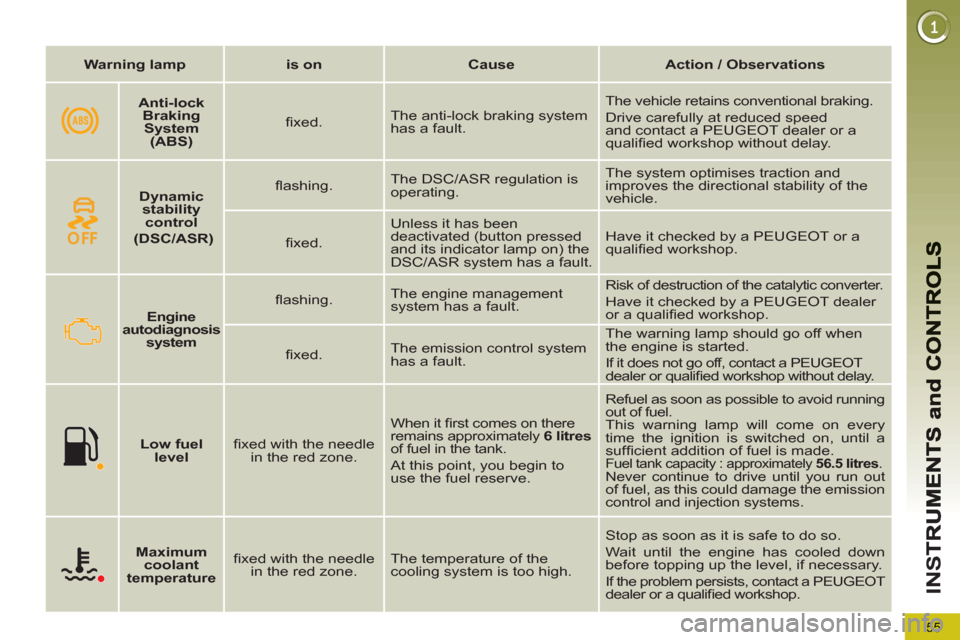
55
IN
S
Warning lamp
is on
Cause
Action / Observations
Engine
autodiagnosis
system
fl ashing. The engine management
system has a fault. Risk of destruction of the catalytic converter.
Have it checked by a PEUGEOT dealer
or a qualifi ed workshop.
fi xed. The emission control system
has a fault. The warning lamp should go off when
the engine is started.
If it does not go off, contact a PEUGEOT
dealer or qualifi ed workshop without delay.
Low fuel
level
fi xed with the needle
in the red zone. When it fi rst comes on there
remains approximately 6 litres
of fuel in the tank.
At this point, you begin to
use the fuel reserve. Refuel as soon as possible to avoid running
out of fuel.
This warning lamp will come on every
time the ignition is switched on, until a
suffi cient addition of fuel is made.
Fuel tank capacity : approximately 56.5 litres
.
Never continue to drive until you run out
of fuel, as this could damage the emission
control and injection systems.
Maximum
coolant
temperature
fi xed with the needle
in the red zone. The temperature of the
cooling system is too high. Stop as soon as it is safe to do so.
Wait until the engine has cooled down
before topping up the level, if necessary.
If the problem persists, contact a PEUGEOT
dealer or a qualifi ed workshop.
Dynamic
stability
control
(DSC/ASR)
fl ashing. The DSC/ASR regulation is
operating. The system optimises traction and
improves the directional stability of the
vehicle.
fi xed. Unless it has been
deactivated (button pressed
and its indicator lamp on) the
DSC/ASR system has a fault. Have it checked by a PEUGEOT or a
qualifi ed workshop.
Anti-lock
Braking
System
(ABS)
fi xed. The anti-lock braking system
has a fault. The vehicle retains conventional braking.
Drive carefully at reduced speed
and contact a PEUGEOT dealer or a
qualifi ed workshop without delay.
Page 70 of 340

M
U
68
Monochrome screen C
16
/9 colour screen
TRIP COMPUTER
System which provides current informa-
tion concerning the trip (range, consump-
tion…).
Depending on your vehicle's
equipment, the trip computer
information appears on the
multifunction screen or on the instru-
ment panel screen.
Information displays
�)
Press the button, located at the end
of the wiper stalk
, to display the
various trip computer tabs in suc-
cession.
With the instrument panel screen
�)
Press the up and down arrows on
the navigator to display the various
trip computer tabs in succession.
Instrument panel screen
With the screen C or the colour screen
Page 93 of 340
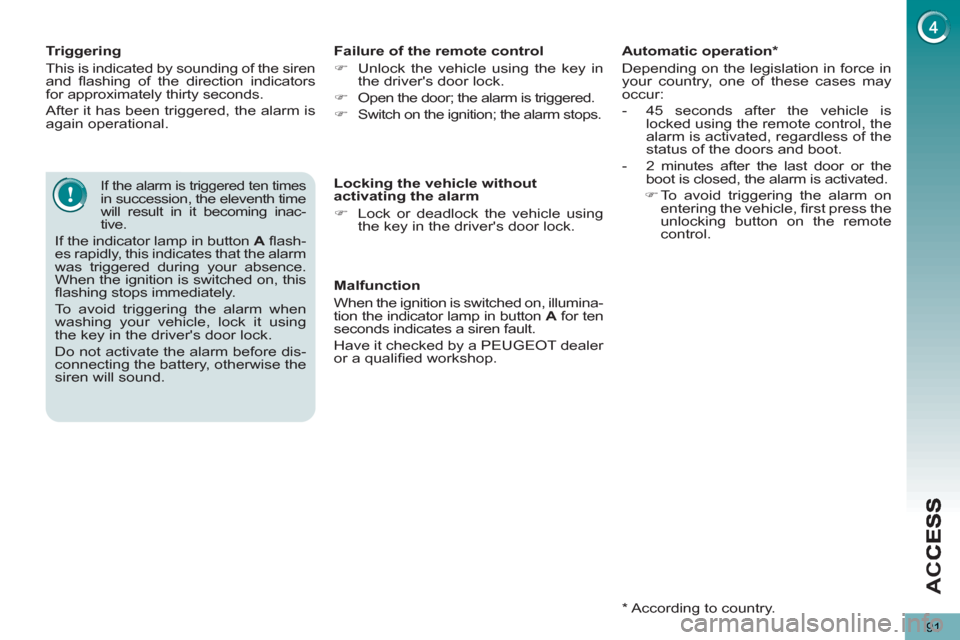
AC
C
91
Triggering
This is indicated by sounding of the siren
and fl ashing of the direction indicators
for approximately thirty seconds.
After it has been triggered, the alarm is
again operational.
If the alarm is triggered ten times in succession, the eleventh time
will result in it becoming inac-
tive.
If the indicator lamp in button A
fl ash-
es rapidly, this indicates that the alarm
was triggered during your absence.
When the ignition is switched on, this
fl ashing stops immediately.
To avoid triggering the alarm when
washing your vehicle, lock it using
the key in the driver's door lock.
Do not activate the alarm before dis-
connecting the battery, otherwise the
siren will sound.
Failure of the remote control
�)
Unlock the vehicle using the key in
the driver's door lock.
�)
Open the door; the alarm is triggered.
�)
Switch on the ignition; the alarm stops.
Malfunction
When the ignition is switched on, illumina-
tion the indicator lamp in button A
for ten
seconds indicates a siren fault.
Have it checked by a PEUGEOT dealer
or a qualifi ed workshop.
Locking the vehicle without
activating the alarm
�)
Lock or deadlock the vehicle using
the key in the driver's door lock.
Automatic operation *
Depending on the legislation in force in
your country, one of these cases may
occur:
- 45 seconds after the vehicle is
locked using the remote control, the
alarm is activated, regardless of the
status of the doors and boot.
- 2 minutes after the last door or the
boot is closed, the alarm is activated.
�)
To avoid triggering the alarm on
entering the vehicle, fi rst press the
unlocking button on the remote
control.
*
According to country.
Page 131 of 340
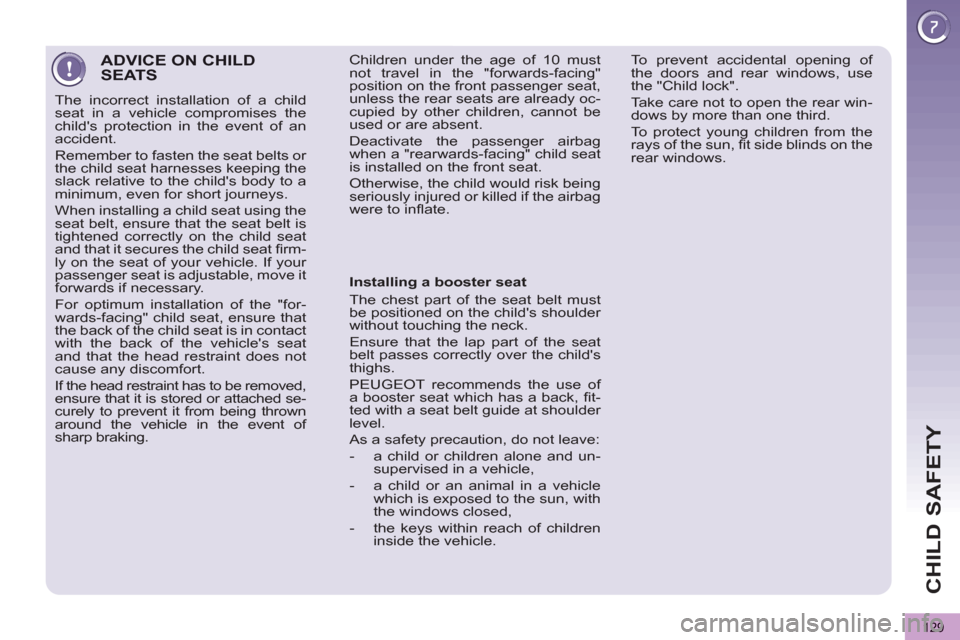
CHILD SAFETY
129
ADVICE ON CHILDSEATS
The incorrect installation of a child
seat in a vehicle compromises the
child's protection in the event of an
accident.
Remember to fasten the seat belts or
the child seat harnesses keeping the
slack relative to the child's body to a
minimum, even for short journeys.
When installing a child seat using the
seat belt, ensure that the seat belt is
tightened correctly on the child seat
and that it secures the child seat fi rm-
ly on the seat of your vehicle. If your
passenger seat is adjustable, move it
forwards if necessary.
For optimum installation of the "for-
wards-facing" child seat, ensure that
the back of the child seat is in contact
with the back of the vehicle's seat
and that the head restraint does not
cause any discomfort.
If the head restraint has to be removed,
ensure that it is stored or attached se-
curely to prevent it from being thrown
around the vehicle in the event of
sharp braking.
Installing a booster seat
The chest part of the seat belt must
be positioned on the child's shoulder
without touching the neck.
Ensure that the lap part of the seat
belt passes correctly over the child's
thighs.
PEUGEOT recommends the use of
a booster seat which has a back, fi t-
ted with a seat belt guide at shoulder
level.
As a safety precaution, do not leave:
- a child or children alone and un-
supervised in a vehicle,
- a child or an animal in a vehicle
which is exposed to the sun, with
the windows closed,
- the keys within reach of children
inside the vehicle. To prevent accidental opening of
the doors and rear windows, use
the "Child lock".
Take care not to open the rear win-
dows by more than one third.
To protect young children from the
rays of the sun, fi t side blinds on the
rear windows.
Children under the age of 10 must
not travel in the "forwards-facing"
position on the front passenger seat,
unless the rear seats are already oc-
cupied by other children, cannot be
used or are absent.
Deactivate the passenger airbag
when a "rearwards-facing" child seat
is installed on the front seat.
Otherwise, the child would risk being
seriously injured or killed if the airbag
were to infl ate.
Page 137 of 340

SA
F
135
ELECTRONIC STABILITY PROGRAMME (ESC)
Definitions
Anti-skid regulation (ASR)
The ASR system (also known as Trac-
tion Control) optimises traction in order
to avoid wheel slip by acting on the
brakes of the driving wheels and on the
engine. It also improves the directional
stability of the vehicle on acceleration.
Dynamic stability control (DSC)
If there is a difference between the path
followed by the vehicle and that re-
quired by the driver, the DSC monitors
each wheel and automatically acts on
the brake of one or more wheels and
on the engine to return the vehicle to
the required path, within the limits of the
laws of physics.
Emergency braking assistance
In an emergency, this system enables you
to reach the optimum braking pressure
more quickly and therefore reduce the
stopping distance.
It is triggered in relation to the speed at
which the brake pedal is pressed. This
is felt by a reduction in the resistance of
the pedal and an increase in the effec-
tiveness of the braking.
Anti-lock braking system (ABS) and
electronic brake force distribution
(EBFD)
This system improves the stability and
manoeuvrability of your vehicle when
braking and provides improved control in
corners, in particular on poor or slippery
road surfaces.
The ABS prevents wheel lock in the
event of emergency braking.
The electronic brake force distribution
system manages the braking pressure
wheel by wheel.
When this warning lamp comes
on, accompanied by an audible
signal and a message, it indi-
cates that there is a fault with the
ABS, which could cause loss of control of
the vehicle when braking.
When this warning lamp comes
on, coupled with the STOP
warn-
ing lamp, accompanied by an
audible signal and a message,
it indicates that there is a fault with the
electronic brake force distribution (EBFD),
which could cause loss of control of the ve-
hicle when braking.
You must stop as soon as it is safe
to do so.
In both cases, contact a PEUGEOT
dealer or a qualifi ed workshop.
When changing wheels (tyres
and rims), make sure that
these are approved for your
vehicle.
Normal operation of the ABS may
make itself felt by slight vibrations of
the brake pedal.
In emergency braking, press
very fi rmly without releasing
the pressure.
Anti-lock braking system (ABS) and
electronic brake force distribution
(EBFD)
Electronic Stability Programme (ESC:
Electronic Stability Control) incorporating
the following systems:
- the anti-lock braking system (ABS)
and the electronic brake force distri-
bution (EBFD),
- the emergency braking assistance,
- the anti-slip regulation (ASR) or
traction control,
- the dynamic stability control (DSC).
Page 185 of 340
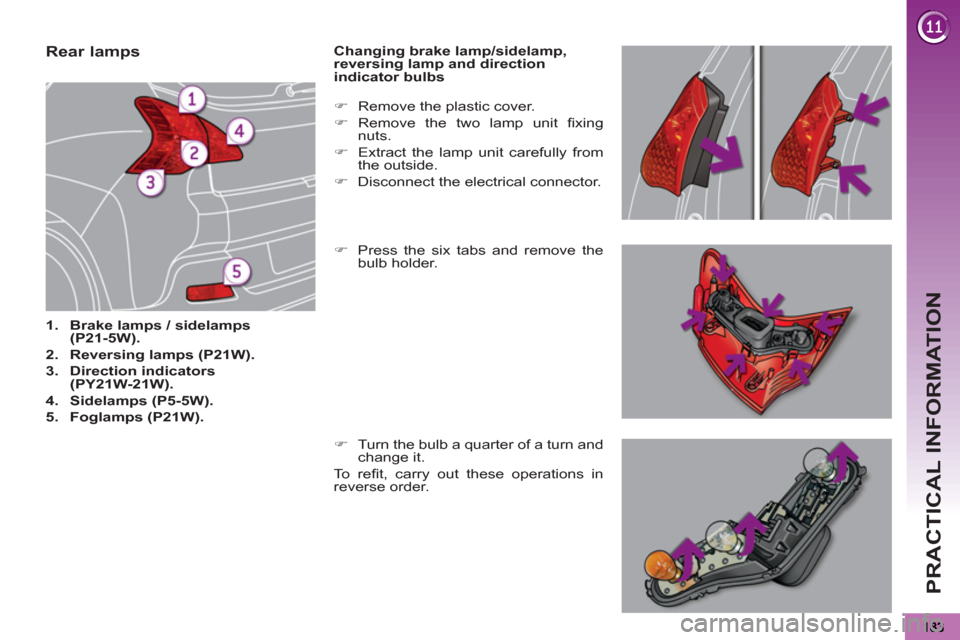
PRACTICAL INFORMATION
Rear lamps
1.
Brake lamps / sidelamps
(P21-5W).
2.
Reversing lamps (P21W).
3.
Direction indicators
(PY21W-21W).
4.
Sidelamps (P5-5W).
5.
Foglamps (P21W).
Changing brake lamp/sidelamp,
reversing lamp and direction
indicator bulbs
�)
Press the six tabs and remove the
bulb holder.
�)
Remove the plastic cover.
�)
Remove the two lamp unit fi xing
nuts.
�)
Extract the lamp unit carefully from
the outside.
�)
Disconnect the electrical connector.
�)
Turn the bulb a quarter of a turn and
change it.
To r efi t, carry out these operations in
reverse order.
Page 193 of 340
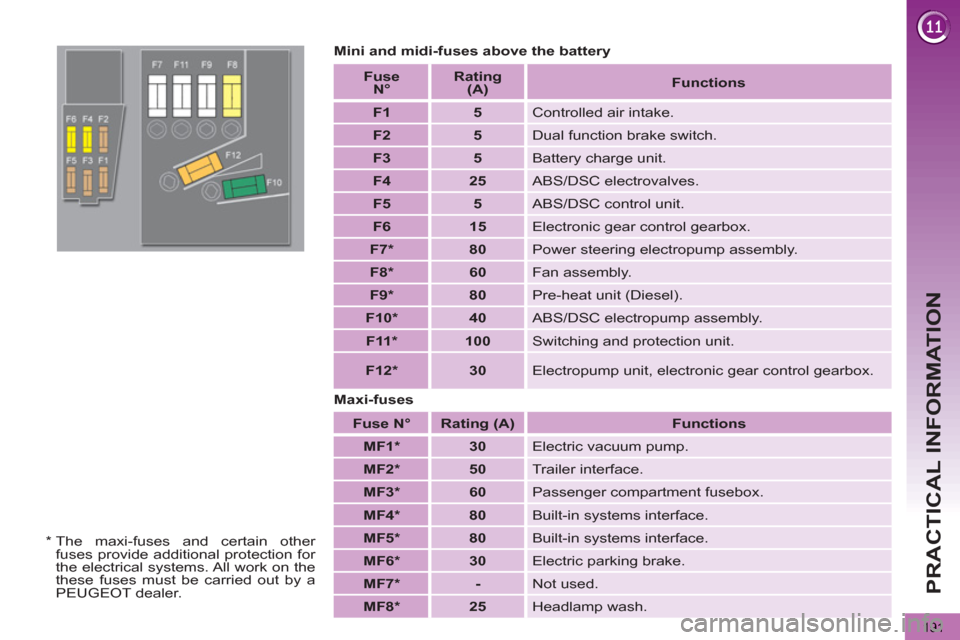
PRACTICAL INFORMATION
191
Mini and midi-fuses above the battery
Maxi-fuses
Fuse
N°
Rating
(A)
Functions
MF1 *
30
Electric vacuum pump.
MF2 *
50
Trailer interface.
MF3 *
60
Passenger compartment fusebox.
MF4 *
80
Built-in systems interface.
MF5 *
80
Built-in systems interface.
MF6 *
30
Electric parking brake.
MF7 *
-
Not used.
MF8 *
25
Headlamp wash.
Fuse
N°
Rating
(A)
Functions
F1
5
Controlled air intake.
F2
5
Dual function brake switch.
F3
5
Battery charge unit.
F4
25
ABS/DSC electrovalves.
F5
5
ABS/DSC control unit.
F6
15
Electronic gear control gearbox.
F7 *
80
Power steering electropump assembly.
F8
*
60
Fan assembly.
F9 *
80
Pre-heat unit (Diesel).
F10 *
40
ABS/DSC electropump assembly.
F11 *
100
Switching and protection unit.
F12 *
30
Electropump unit, electronic gear control gearbox.
*
The maxi-fuses and certain other
fuses provide additional protection for
the electrical systems. All work on the
these fuses must be carried out by a
PEUGEOT dealer.